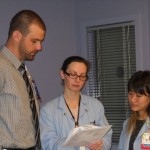Editor’s Note: Paul W. Abramowitz, Pharm.D., FASHP, began his job as ASHP Executive Vice President and CEO January 1, replacing Dr. Henri R. Manasse, Jr., Ph.D., Sc.D. Dr. Abramowitz was formerly the associate hospital director for professional services and chief pharmacy officer at the University of Iowa Hospitals and Clinics, and Professor and Assistant Dean at the College of Pharmacy, Iowa City. InterSections sat down with Dr. Abramowitz to get a sense of what he sees ahead for ASHP and health-system pharmacy.
 What do you foresee as the biggest challenges for ASHP, and for you as its new leader?
What do you foresee as the biggest challenges for ASHP, and for you as its new leader?
Very high on my agenda is to meet the goals set forth at the Pharmacy Practice Model Initiative (PPMI) Summit to change our practice model. In addition, we need to achieve our objective of expanding residency training so that all new graduating pharmacists in health systems are residency trained by 2020. I would also like to see ASHP work to enhance the public’s understanding of what we do as pharmacists, so that patients insist that their health care team always includes a pharmacist. It would also be timely for us to again look at our membership organizational structure and our policy-making process to see if we can better serve our members and more rapidly accomplish some of the things they would like us to do. Of course, all of this will require that ASHP has a robust “product line” providing value and generating the necessary revenues to support our membership services.
How has your background in health care, as a practitioner and an administrator, prepared you for being CEO?
I’ve worked in hospitals and health systems in various roles for 34 years. So I think I bring to this position a good understanding of many aspects of health-system pharmacy practice. I also served three terms on the ASHP board of directors, including as president and treasurer. When I put that together—a strong practice perspective as well as a strong understanding of ASHP organizational and professional issues—I feel very comfortable stepping into the office.
Why did you want to become CEO?
If I’ve accomplished anything in my years as a pharmacist, it’s been due to three things: great teams of people I’ve worked with in various organizations; the many colleagues and mentors who have helped me along way; and, perhaps most importantly, ASHP itself. Throughout my career, I’ve found that ASHP has provided me not only with a wealth of both professional and scientific information, but also many colleagues, friends and networking. I am greatly indebted to ASHP, and I want to continue to give back to ASHP. This position will allow me to do that and also help advance health-system pharmacy. For me, this is my ideal job. So that’s what attracted me to the position, and that’s what I told the search committee and the board of directors during the interview process.
How would you describe your style of leadership?
I have a very open, informal style, and I’m very participatory by nature. I like to involve, very significantly, the people that I work with. I may have ideas and thoughts about directions, but I believe the power of collective wisdom is much greater than that of an individual and should be used to help guide decision making. However, I recognize that a leader needs to make decisions and I will not hesitate to do so. If I had to apply a management term, my style is participatory but situational, depending on what needs to be done.
What changes would you like to see in clinical pharmacy practice?
I anticipate that in five to 10 years, health-system pharmacists will be seen as an absolutely necessary member on every patient care team. I hope that the extent and provision of services outlined in the PPMI become universal in all hospitals, health systems, clinics and ambulatory care centers. I also hope that patients insist that pharmacists be very involved in their care and recognize how we can help them improve the outcomes of their medication therapy. I hope that collaborative practice expands and evolves to the point that pharmacists can make full use of their knowledge and abilities for our patients.
How can ASHP help to achieve those goals?
ASHP must change and evolve to ensure that across the nation, we support the needs of everything from 25-bed critical-access to 1,000-plus bed hospitals. We need to be able to support our members practicing in all of those facilities. ASHP must also provide the support and encouragement for what I believe will become a fast-growing part of our membership—pharmacists practicing in ambulatory clinics of all sizes.
What else would you like to say to ASHP members and staff to introduce yourself?
I believe that the dedication and participation of our entire membership is unparalleled. We have exceptional volunteer leaders and the most talented and hard-working staff of any professional association in the world. When one puts those three ingredients together, it says that ASHP can accomplish anything we set our mind to. I’m honored to be in this position to build upon the legacy of my three CEO predecessors and help lead ASHP to even higher levels.








 If you want to contribute tutorials, news or other stuff please contact us. We pay 150 for each approved article.
If you want to contribute tutorials, news or other stuff please contact us. We pay 150 for each approved article. Consectetur adipisicing elit. Sed do eiusmod tempor incididunt ut labore.
Consectetur adipisicing elit. Sed do eiusmod tempor incididunt ut labore. This site uses valid HTML and CSS. All content Copyright © 2010 Newscast, Inc
This site uses valid HTML and CSS. All content Copyright © 2010 Newscast, Inc If you like what we do, please don't hestitate and subscribe to our
If you like what we do, please don't hestitate and subscribe to our